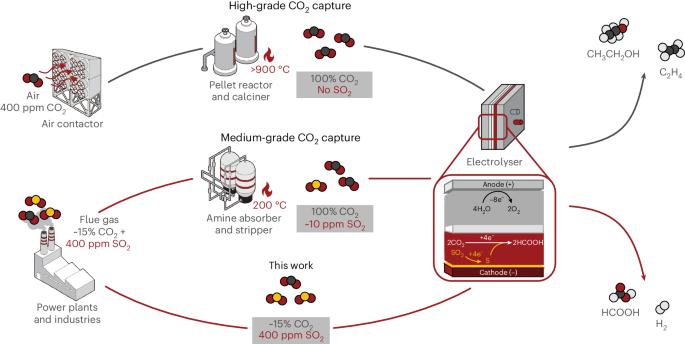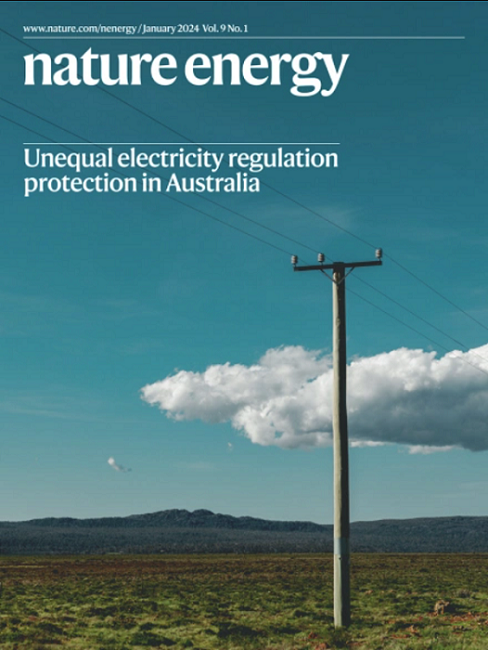利用聚合物/催化剂/离子体异质结设计提高二氧化碳还原电催化剂的二氧化硫耐受性
IF 49.7
1区 材料科学
Q1 ENERGY & FUELS
引用次数: 0
摘要
工业烟气中的高浓度 CO2 使这些点源成为将 CO2 转化为产品的可再生能源电催化的候选对象。然而,普通烟气中的痕量二氧化硫会迅速且不可逆地毒害催化剂。我们在此报告,限制电化学活性位点附近的氢吸附可使二氧化硫失活,从而实现二氧化碳的高效转化。我们通过聚合物/催化剂/离子体异质结设计实现了这一方法,该设计结合了疏水和高电荷亲水结构域,可减少氢气吸附并促进二氧化碳而非二氧化硫的传输。我们开发了一种耐二氧化硫的系统,在 100 mA cm-2 的条件下,该系统能在 150 小时内对多碳产品保持约 50% 的远达效率。将这一策略扩展到高表面积复合催化剂后,在含有 400 ppm SO2 的二氧化碳流中,我们获得了 84% 的法拉第达效率、高达 790 mA cm-2 的部分电流密度和 ~25% 的多碳产品能效,这一性能可与使用纯二氧化碳的最佳报告相媲美。本文章由计算机程序翻译,如有差异,请以英文原文为准。


Improving the SO2 tolerance of CO2 reduction electrocatalysts using a polymer/catalyst/ionomer heterojunction design
The high concentrations of CO2 in industrial flue gases make these point sources attractive candidates for renewably powered electrocatalytic conversion of CO2 to products. However, trace SO2 in common flue gases rapidly and irreversibly poisons catalysts. Here we report that limiting hydrogen adsorption in the vicinity of electrochemically active sites deactivates SO2 to enable efficient CO2 conversion. We realize this approach via a polymer/catalyst/ionomer heterojunction design with combined hydrophobic and highly charged hydrophilic domains that diminish hydrogen adsorption and promote CO2 over SO2 transport. We develop an SO2-tolerant system that maintains ~50% faradaic efficiency towards multi-carbon products for over 150 h (at 100 mA cm–2). Extending this strategy to a high-surface-area composite catalyst, we achieve faradaic efficiencies of 84%, partial current densities of up to 790 mA cm–2 and energy efficiencies of ~25% towards multi-carbon products with a CO2 stream containing 400 ppm SO2, a performance that is competitive with the best reports using pure CO2. While the high concentration of CO2 in flue gas makes it an attractive feedstock for electrocatalytic production of useful molecules, SO2 contaminants can poison catalysts. Here the authors report a polymer/catalyst/ionomer heterojunction design with hydrophobic and hydrophilic domains that improves the SO2 tolerance of a Cu catalyst.
求助全文
通过发布文献求助,成功后即可免费获取论文全文。
去求助
来源期刊

Nature Energy
Energy-Energy Engineering and Power Technology
CiteScore
75.10
自引率
1.10%
发文量
193
期刊介绍:
Nature Energy is a monthly, online-only journal committed to showcasing the most impactful research on energy, covering everything from its generation and distribution to the societal implications of energy technologies and policies.
With a focus on exploring all facets of the ongoing energy discourse, Nature Energy delves into topics such as energy generation, storage, distribution, management, and the societal impacts of energy technologies and policies. Emphasizing studies that push the boundaries of knowledge and contribute to the development of next-generation solutions, the journal serves as a platform for the exchange of ideas among stakeholders at the forefront of the energy sector.
Maintaining the hallmark standards of the Nature brand, Nature Energy boasts a dedicated team of professional editors, a rigorous peer-review process, meticulous copy-editing and production, rapid publication times, and editorial independence.
In addition to original research articles, Nature Energy also publishes a range of content types, including Comments, Perspectives, Reviews, News & Views, Features, and Correspondence, covering a diverse array of disciplines relevant to the field of energy.
 求助内容:
求助内容: 应助结果提醒方式:
应助结果提醒方式:


